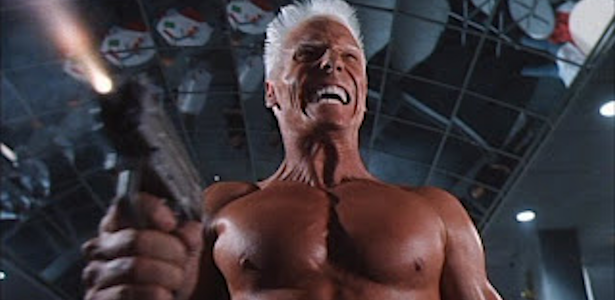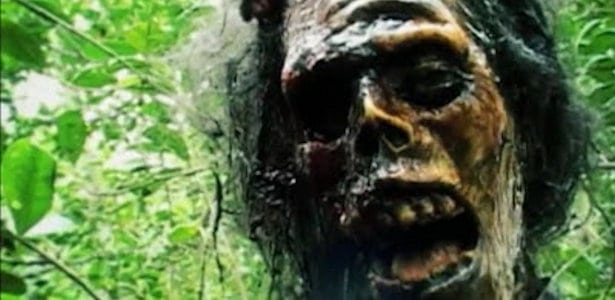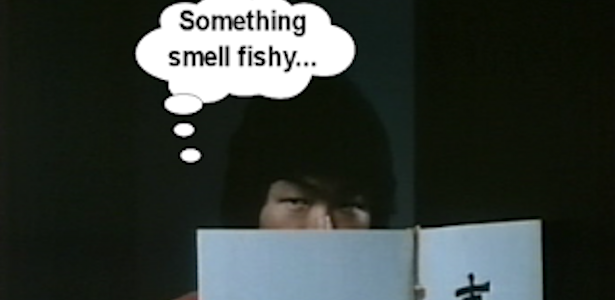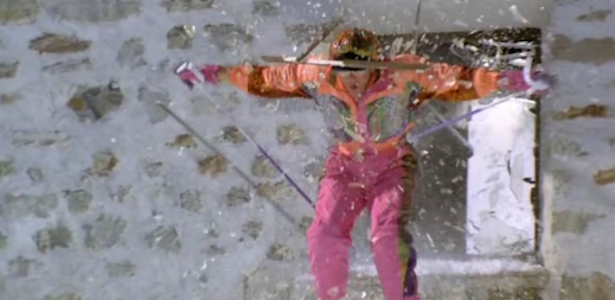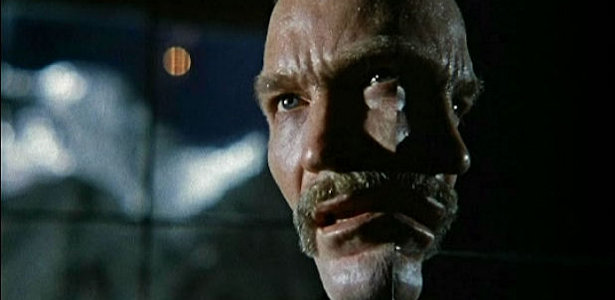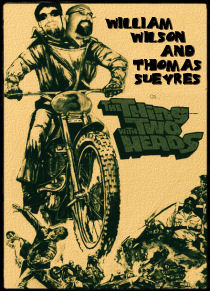“There is a review out there that says this is obviously a made up name. I always wanted to write that guy and say, ‘Here I am.’”
– Samson Aslanian, co-creator of TORMENT

Thank goodness for unique names. When it comes to film research, you’re always happy to see a subject with a distinctive name, since common names can send you into Google seizures. The underrated thriller TORMENT (1986) gave me both in co-directors/writers/producers Samson Aslanian and John Hopkins. Sharp-eyed horror fans will probably recognize their names as production manager and assistant director, respectively, in the credits for THE DORM THAT DRIPPED BLOOD (1982) and THE POWER (1984), the first two features from another directing duo, Jeffrey Obrow and Stephen Carpenter. Care to guess who I was able to locate? Not only was Sam Aslanian easier to find, he was also easy to approach and within days of our initial contact we were talking his feature debut TORMENT.
A first generation Armenian-American, Aslanian was born and raised in the city of San Francisco. Growing up, he had the desire to become a comic book illustrator and later a psychologist; little did he know that a vocation awaited him that would benefit from both interests. It was while in high school, where he enjoyed studying drama and art, that Aslanian first caught the filmmaking bug. “In twelfth grade they had advanced placement art and I was really excited,” he explains. “So I went in the first day and I realized they were going to do filmmaking for that semester. At first I was bummed and going to change classes, but then I thought I should just stick it out and I just really, really liked it.”
Post-high school Aslanian pursued college, but still felt unsure of his direction. It was a fortuitous meeting with a guidance counselor at San Francisco City College that soon sent him on his way. “I was sitting across from this really crusty counselor who had seen it all who goes, ‘So, kid, what do you want to do?’ And I said, ‘I think I want to be a psychologist’ and he goes, ‘Is that what you really want to do?’ And I go, ‘No. No, I really want to be a filmmaker’ and he goes, ‘Then why the hell are you sitting here telling me you want to be a psychologist?’ And he pulls out stuff from USC and UCLA and showed me if you do this, this, and this you can get into these schools.”

With a fire lit under him, Aslanian worked to meet the required goals to transfer and was soon accepted by both USC and UCLA. He opted for the latter due to financial reasons, and soon found himself in the filmmaking program where he fell in with the right crowd – namely Jeffrey Obrow. “He was my teacher’s assistant on one of the courses and he was best friends with Steve Carpenter,” he says. “They had come up with this plan that they were going to make this low budget horror film out of UCLA. I sort of fell in with them and I became the production manager of THE DORM THAT DRIPPED BLOOD. Here I was 21-years-old, production managing a feature and not knowing anything about what I was doing. There I met the first assistant director, John Hopkins.”
Released theatrically by New Image in April 1982, THE DORM THAT DRIPPED BLOOD (aka PRANKS; aka DEATH DORM) landed right in the middle of the slasher cycle and proved to be successful enough to warrant a second feature. The same team quickly reunited for the supernatural film THE POWER (1984) with Aslanian and Hopkins again picking up the same production duties. It was while wrapping up this sophomore feature that talk of a third film began. Having seen success in directing/writing duos, Obrow split his friends up into groups of two and gave them a specific twist to build a film around. Naturally, Aslanian and Hopkins were paired up with each other and quickly came up with their spin on Obrow’s plot point, which we won’t reveal here.
“John Hopkins and I went on a walk,” he reveals of the film’s genesis, “and we talked about the old ALFRED HITCHCOCK PRESENTS. John remembered this one where there was a killer loose [after a] nurse and they lock up the house and they realize he is in the house. We kind of took that and riffed on it. Literally the TORMENT you see we came up with in about 45 minutes.”
The duo took their idea to Obrow who, surprisingly, didn’t like it. Not wanting to let a good idea go, they asked if they could develop it and Obrow agreed. Thus, TORMENT was born. By now living as roommates, Aslanian and Hopkins spent the next few months writing their script. “We would work on a job,” he says, “or I would go to school and come home and then we would spend the evening writing.”

Although primarily fans of the action and western films of the 1950s and 1960s, the duo did look at some classic thrillers in order to create a model for their film. “There was an Audrey Hepburn movie called WAIT UNTIL DARK (1967), we took that as one of our templates. And there was a movie with Mia Farrow from the early ‘70s called SEE NO EVIL (1971), where she is blind. We took this ‘put upon women in large houses’ [subgenre] template.” The neophyte screenwriters ended up with a script they were happy with and soon began the pre-production process on their story of a serial killer loose in San Francisco who targets the mother and fiancé of the lead detective investigating his crimes.
Funding was obviously the first step. As with the two earlier features they had worked on, Aslanian and Hopkins looked toward their film school friends for support. “We went to our families and friends,” Aslanian explains of the film’s financing. “John put in a lot of the money, he had some family money. My parents and sisters put in money. It wasn’t very much money. It was back then, it seemed like the weight of the world to us. We had these cocktail parties at my parents’ house where we invited friends over and we sold $500 dollar shares [in the film].” In total, they amassed $100,000 to begin their film, which would ultimately it cost $160,000.
This support from friends also extended behind the camera. Many alumni from DORM and THE POWER returned and, in a bit of a role reversal, Stephen Carpenter worked as the director of photography for his former assistants and Jeffrey Obrow served as a production consultant. And Stacey Giachino, associate producer on both Obrow/Carpenter films and co-writer for DORM, came on as line producer.
Next up was casting the film, which proved to be hard despite the film only offering four major roles. Warren Lincoln, the obsessive boyfriend in THE POWER, came over to play the role of the young detective Michael Courtland; veteran stage star Eve Brenner essayed the role of Mrs. Courtland; and Taylor Gilbert was chosen via casting sessions in San Francisco to play Michael’s fiancée Jennifer.

However, the final role of the nameless killer was the most difficult to cast until Aslanian went back to his recent past. “That’s the best story there,” Aslanian relays. “We were looking for somebody to play that role and I remembered my high school drama teacher, Mr. Witt. We drove up to San Francisco and went to my high school. He’d been more than a drama teacher. He was the guy who got me interested in theater and directing. He was kind of a mentor figure to me. So we showed him the script. He read the script and said, ‘This is a piece of crap. If you shoot it like this, you’re going to be in for a world of hurt,’ which we were. And then we asked him and he said, ‘Yeah, okay, I’ll do it.’” Not only did Witt agree to the project, he also got his wife, Najean Cherry, a role as one of the victims. “The housekeeper was Bill Witt’s wife in real life. He was looking forward to her death a little too much,” he reveals with a laugh.

Having production managed two features that were distributed theatrically Aslanian knew the pitfalls facing a low budget production. He had built a rapport with several rental houses and was able to get great rates. An extra dose of youthful gravitas on Aslanian’s end also helped in making the film look good. “I actually asked for a meeting with the president of Panavision and they gave it to me,” he says. “I went in said I’d like to use a Panaflex for this movie I’m doing on 35 millimeter. He took out a pencil and said, ‘So how much are you willing to spend?’ And I said, ‘Nothing. I’ve got nothing. I’m asking you to donate it.’ He laughed and goes, ‘You have a lot of balls’ and he said whatever you need, just call in. So he let us use the Panaflex for free. When you’re 23 or 24-years-old, people want to cut you breaks, especially if you are really serious and really care about what you are doing.”

Aslanian’s ability to get things for free also extended to the locations. The production was able to secure Fort Point – a former military installation and National Historic site in the shadow of the Golden Gate Bridge – for one of the crime scenes (see pic right). And the main location, where 80% of the action takes place, was even closer to home. “That’s my parents’ house,” he reveals. An unperceivable bit of on location trickery involving a tiny matte painting transported the house from a San Francisco suburb to a seemingly isolated locale on a hillside. “We shot and slept there. They had kind of a ballroom thing in the basement. We rented out a bunch of cots and 15 guys slept in there. It was called ‘The Pit.’ Not only did my parents not mind, my dad cooked all the food and catered for the crew the whole time.”
The Aslanian home isolated via movie magic:
Filming took place over the course of 1984 with an initial shoot 10 day initial shoot and a few subsequent shoots to pick up sections. “It was shot piecemeal because we could never keep a crew for long enough to shoot a whole feature,” he relates. “So we shot in sections. The crew was our friends – David Cunningham, Walter Gorey and Chris Hopkins – guys that we went to school with who did multiple jobs. So when they were available, we’d say, ‘In three weeks we want to go and shoot for four days, can you take a couple of days off school?’”

Co-directing is rare on feature films. When asked exactly how the directing dynamic worked with Hopkins, Aslanian said it became apparent very early on that each of them had their own strengths – Aslanian handled many of the intricate camera moves, while Hopkins worked with the actors. “I really like photography so Steve Carpenter and I sort of worked hand-in-hand making sure those shots happened correctly,” he says. “And John had a great aptitude in working with the actors.

He was great at sitting with them, going over their dialogue and blocking them. I’m not saying I didn’t do that and he didn’t work on the camera stuff too. It is just that is kind of how it split up after a while where I became more interested in the visuals and lighting schemes and John worked very well and hard with the actors.”
Working with trained theater actors such as Brenner and Witt also improved the production. There is a section in the middle of the film where the two elder characters play a bit of cat-and-mouse. This is Aslanian’s favorite section of the film and it was enhanced by some improvisation from the actors. “We would meet mid-morning and let those two improvise and then we would type that up as the evening’s scene,” he says of the organic developments. “It was just so much better than the stilted stuff we’d been writing. It was just a lot funnier and a lot fresher. [Witt] came up with the ‘Good Ship Lollypop’ thing. He had two daughters and said that’s what he sang to them. And so now he is demented so how would he [sing it].”

Once the principal photography was in the can, the team sat down to edit. Editing was complex and employed the use of three friends to piece the film together. “When we were editing, all three of the editors – Earl Ghaffari, John Penney and Bret Shelton – had regular jobs,” Aslanian explains. “So they would work and after work come over. We’d make them a dinner and they would work late into the night, go home and then go to work the next day.” An early screening of the film for friends convinced the filmmakers to cut back on their material a bit, dropping dramatic portions of the opening hour in order to get to the action faster.
With their endeavor complete, the filmmakers began shopping their product around. As with the preproduction period, they knew the importance of getting it into the hands of the right people. “Sometimes young filmmakers make a movie and then don’t get the top quality people afterwards – the right attorneys, the right producers representatives. Our representative at the time was Jeff Dowd,” Aslanian says. Interestingly, Dowd – an eccentric who would later be the basis for Jeff Bridges’ character in THE BIG LEBOWSKI (1999) – was representing another thriller at the time by a directing duo. That film was Joel & Ethan Coen’s BLOOD SIMPLE (1984). Amusingly, a positive review of TORMENT in
the L.A. Times compared it to Coen brothers’ debut.
One of the many atmospheric shots in TORMENT:
With Dowd’s help, the film was screened to various companies over the course of a week and eventually found a home at New World Pictures. “There were other people who wanted it, but they just weren’t willing to pay as much up front,” Aslanian recalls of the film’s studio courtship. “New World paid $400,000. We paid the crew, accountants and production representatives. In the end, for 25-year-olds making movies, we ended up with a nice payday.” Yes, TORMENT is that rare cinematic beast – a low budget film that actually made the creators money.
 |
| TORMENT ad from Illinois |
Unfortunately, once the film was under New World’s umbrella, the filmmakers were cut out of any creative discussion on how to market the film. While an effective poster was designed (see above), the studio came up with a horrible tagline (“If the suspense doesn’t get you, the terror will? It’s such a crap line,” Aslanian laughs) for its theatrical run in the spring of 1986. To make matters worse, the eventual New World home video release actually spoils the film’s major twist right on the back of the box. Adding insult to injury, the studio borrowed behind-the-scenes photographs for potential promotional materials and promptly lost them all. “We took all these photos during the film,” Aslanian explains. “They took all the negatives and then they lost them all. All these personal photographs of our life are gone.”
New World rolled the film out across the country with 100 prints. Aslanian and friends were there front and center when the film opened in Los Angeles, only to find out their low-key ending didn’t satiate viewers hungry for blood. “We went to see it the first night in Westwood when it opened,” he says. “The audience – a bunch of UCLA kids – were really into it. And then it ended and the credits come up and the whole audience erupted in boos. And we were like, ‘Ohhh, shit.’ We were on such a high though. We were just so happy that it was out. It was a three year process. We were exhausted but happy to have money in our pockets and glad that it had good reviews. It was too late to do anything. In retrospect, we should have gone through the floorboards with a TERMINATOR kind of ending.”
TORMENT folks circa Halloween 1986:
Top (l-to-r): Jon Penney (co-editor), John Hopkins, Sam Aslanian, Earl Ghaffari (first AD, co-editor), Michelle Ghaffari
Bottom (l-to-r): Greg Hollobaugh (formerly Unknown Suicidal Man), DD Aslanian
Such negatives did little to dampen the filmmakers’ elation of having successfully completed and released their first feature. Their agent lined them up to interview with Universal about directing PSYCHO III (1986) in 1985, but they turned the meeting down, opting instead to work on their next script. Their sophomore screenplay, an action-thriller titled SIEGE, drew attention and soon found them an office at Warner Bros. The duo seemed to be on their way when they suddenly encountered Hollywood’s equivalent of a serial killer – development hell. Also known as BROTHERS IN ARMS, their screenplay was a RIO BRAVO (1959)-like story about two black brothers – one a sheriff, one a criminal – in an isolated Washington town who must fend off a group of White Supremacists trying to break out one of their members. Cue the politically correct studio execs.
“The first thing that happens is they didn’t want both characters to be African American. One brother is the Sheriff and the other brother is a con coming out of prison on parole. They said, ‘The other brother has to be a white guy.’” Aslanian relates with a sense of astonishment. “And then Warner Bros. chickened out on the White Supremacist thing. They said, ‘Let’s just make them mercenaries.’ Mercenaries that do what? So much was based on that fact that White Supremacists thought the white citizens of this town would fully turn against the Sheriff because he’s black. And in the end, they didn’t and stood right by him.”

With the subtext seemingly lost on the executives in subsequent meetings, the script went unproduced over a period of years. Aslanian and Hopkins eventually went their separate ways in 1990 (with Hopkins later seeing a film noir script he wrote about a boy in a hotel who admires a detective morph into the “kid and orangutan in a hotel” epic DUNSTON CHECK IN [1996]). Aslanian, however, went in the opposite direction of features as he joined the world of music videos. He contacted old UCLA pal Tim Clawson at Propaganda Films and started working on music videos there before moving over to the company DNA. There he rose to the role of Vice President and oversaw projects for artists such as Madonna, Ice T, Nine Inch Nails, and Red Hot Chili Peppers.
 |
Sam Aslanian
(photo by Marc Webb) |
The combination of the audio and visual mediums proved to be a perfect fit for Aslanian. “First off all, I love music. I have over 3,000 vinyl albums,” he explains. “Second of all, honestly, it was the speed. Your idea goes in on a Monday, it’s accepted by a Tuesday, you’re shooting by the weekend, and you’re delivering by the next Thursday. And you’re being paid. I liked the energy of music people. They are almost always high energy and have a lot of passion for what they do. It was a lot more fun being on music videos than being in our condo writing.”
Ironically, with only one feature film from the 1980s to his name, Aslanian has made a huge contribution to current cinema. While at DNA, he discovered and helped to develop two major talents – future blockbuster directors Francis (THE HUNGER GAMES) Lawrence and Marc (THE AMAZING SPIDER-MAN) Webb. “We started them both off as baby directors straight out of college,” he explains, “and we developed them into good music videos directors. Those guys work harder than anyone you’ve ever seen work in your life.”

While not everyone knew his directing past, Aslanian was able to impart advice that he wishes he had given himself. “John and I made some stupid mistakes along the way. Nah, we don’t want to do PSYCHO III, we want to do our own stuff,” he reveals of their post-TORMENT times. “It was like, ‘You idiots! Go out, learn how to direct. Do some work, make some money.’ It is funny because that is the advice I gave dozens of young directors in the music video world. I wouldn’t allow them to turn down projects.”
Aslanian retired from the music video industry in 2005 (“I get bored after a while,” he jokes). He is currently a fine art photographer specializing in the artistic use of old film stock and has just released a collection of his work,
Perspective Napa Valley. When asked for his thoughts on the film from 30 years ago, he is surprised and impressed that they were able to get so much done on so little amount of money. Even more impressive is that it was a 100% collaborative effort, a feat usually susceptible to conflict and tension. “It was very much a co-writing, co-directing, co-producing situation,” he says of the union that bore TORMENT. “John couldn’t have done it without me and I couldn’t have done it without John.”
Note: This entry should really read "Written by Bill Picard and William S. Wilson." Mr. Picard, the Internet's Miss Marple, not only turned me onto the film, but helped provide valuable research and questions for Mr. Aslanian. Also, we tried out damnedest to find John Hopkins, but such a common name combined with a certain private research University made that a tough one to crack. If you are out there, I hope you get a chance to read this and thanks for the movie! In addition to Blake continuing to lose it in rather spectacular fashion, the father of the dead girl that Blake found turns out to be a drunken wife-beater who thinks he can stick Costello with his blade for being nosey. Big mistake. Come to think of it, it seems like the only person with his feet firmly on the ground is Detective Extralarge. Or at least you would think that, wouldn't you? Costello casually spends his leisure time blowing his sax at his favorite club, The Blue Monkey. I mean, the guy has killed almost a dozen girls already, there's no reason to spend every waking minute trying to solve the case. Just as an aside, I like to think that the owner of club is a big fan of hospital horror and giant bug movies.
In addition to Blake continuing to lose it in rather spectacular fashion, the father of the dead girl that Blake found turns out to be a drunken wife-beater who thinks he can stick Costello with his blade for being nosey. Big mistake. Come to think of it, it seems like the only person with his feet firmly on the ground is Detective Extralarge. Or at least you would think that, wouldn't you? Costello casually spends his leisure time blowing his sax at his favorite club, The Blue Monkey. I mean, the guy has killed almost a dozen girls already, there's no reason to spend every waking minute trying to solve the case. Just as an aside, I like to think that the owner of club is a big fan of hospital horror and giant bug movies. Much like Scotland Yard in the Sherlock Holmes stories, the cops are just begging for our detective to solve the case. Not so much in word, but in deed. When bondoed bullet holes have been discovered on the priests black car, the police don't want to even bring him for questioning! The chief waxes philosophical, "Miami is full of cars full of holes, especially bullet holes." I'm pretty sure the only time that was said in real life was over a bong hit. Maybe this guy should run for mayor in Canada.
Much like Scotland Yard in the Sherlock Holmes stories, the cops are just begging for our detective to solve the case. Not so much in word, but in deed. When bondoed bullet holes have been discovered on the priests black car, the police don't want to even bring him for questioning! The chief waxes philosophical, "Miami is full of cars full of holes, especially bullet holes." I'm pretty sure the only time that was said in real life was over a bong hit. Maybe this guy should run for mayor in Canada.
 In addition to Blake continuing to lose it in rather spectacular fashion, the father of the dead girl that Blake found turns out to be a drunken wife-beater who thinks he can stick Costello with his blade for being nosey. Big mistake. Come to think of it, it seems like the only person with his feet firmly on the ground is Detective Extralarge. Or at least you would think that, wouldn't you? Costello casually spends his leisure time blowing his sax at his favorite club, The Blue Monkey. I mean, the guy has killed almost a dozen girls already, there's no reason to spend every waking minute trying to solve the case. Just as an aside, I like to think that the owner of club is a big fan of hospital horror and giant bug movies.
In addition to Blake continuing to lose it in rather spectacular fashion, the father of the dead girl that Blake found turns out to be a drunken wife-beater who thinks he can stick Costello with his blade for being nosey. Big mistake. Come to think of it, it seems like the only person with his feet firmly on the ground is Detective Extralarge. Or at least you would think that, wouldn't you? Costello casually spends his leisure time blowing his sax at his favorite club, The Blue Monkey. I mean, the guy has killed almost a dozen girls already, there's no reason to spend every waking minute trying to solve the case. Just as an aside, I like to think that the owner of club is a big fan of hospital horror and giant bug movies. Much like Scotland Yard in the Sherlock Holmes stories, the cops are just begging for our detective to solve the case. Not so much in word, but in deed. When bondoed bullet holes have been discovered on the priests black car, the police don't want to even bring him for questioning! The chief waxes philosophical, "Miami is full of cars full of holes, especially bullet holes." I'm pretty sure the only time that was said in real life was over a bong hit. Maybe this guy should run for mayor in Canada.
Much like Scotland Yard in the Sherlock Holmes stories, the cops are just begging for our detective to solve the case. Not so much in word, but in deed. When bondoed bullet holes have been discovered on the priests black car, the police don't want to even bring him for questioning! The chief waxes philosophical, "Miami is full of cars full of holes, especially bullet holes." I'm pretty sure the only time that was said in real life was over a bong hit. Maybe this guy should run for mayor in Canada.




